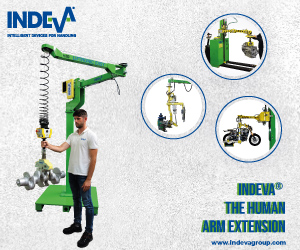Articles
Palletisers, Palletising Equipments & Systems eases PlantAutomation Process

One can wonder, when there are no Palletising Equipments & Systems in today’s factories. It’s very difficult to imagine a modern distribution system without pallets and palletized loads. With the exclusion of single parcel shipments, just about everything being shipped in any quantity, anywhere anytime is done by placing the products on a pallet and unitize into a compact high-density load for transport. Pallets are stacked, placed on racks (shelves) and handled in many different ways with the aim to deliver products quickly and efficiently. Pallets have made bulk handling of product extremely simple and the fork lift truck that moves pallets is common in stores, warehouses and any area where product is moved.
Palletising Process
A pallet is a raised platform upon which goods are placed for transport. Typically, the palletized items – cases, bags, cans, bottles, etc. – are smaller than the pallet. The pallet becomes a space efficient, easily handled transport mechanism for all of the smaller items. It may be made of wood, plastic, metal or corrugated kraft board and is usually rectangular in shape with the standard size of 40 in. x 48 in. The product is arranged on the pallet in an orderly and compact pattern permitting efficient handling throughout the distribution system. Patterns conform to the pallet shape and produce the optimized load in the
pallet dimensions while maintaining structural strength forthe load.
Pattern design is dictated by how the pallet is handled in the distribution system. Pallets with a pattern designed for a shipping container may be different than those that move through a trucking system and a racked warehouse in a distribution center. The cases are not stacked the same on each layer on most pallets. Rather, an interlocked arrangement of cases is used to stabilize the load. Cases are arranged by length and width against each other to form a layer of the multiple layers in the unit load. Unless the cases are heavy or large, the tiers or layers are changed, normally rotated 180 degrees, to maintain structural strength in the stack of the load and to keep the layers from breaking apart in transit.
In the past when products were stacked, hand palletization was used. While it is the most versatile way to stack product on a pallet, this method is only effective when the rate of product being palletized is slow. But today, Automated single product palletization with a single pallet pattern evolved from hand palletization is highly used and is on demand. High-level palletizers were developed to handle high-speed production operations that produced product at 50 to 60 (or more) cases per minute. The machines quickly placed and stacked cases on a pallet for shipment.
Most high-level palletizers can handle six layers or tiers of product per minute. This modest beginning of one type of machine from the mid 20th Century has now evolved and expanded into a variety of methods for placing and arranging products on a pallet.
Evolution of Palletisers and Palletising Equipments:
From manual assist equipment to sophisticated utomated and robotic technology, here’s a look at a few palletizing solutions.
Manual palletizing: Manual palletizing is done by people and without any mechanical assistance at all.
Backboard: Since product placement on a pallet is important to the load’s structure, a backboard can be used to guide the loading process. Typically about 4 feet long and 6 feet high, a backboard is made of steel and welded together in a 90 degree angle, It’s a simple alignment aid that means workers spend less time lining up the product as they build the load, he adds.
Lift assist and positioning: Manual palletizing can also be facilitated with assist devices like powered lift tables or work positioners that are specifically designed for palletizing functions.
Using calibrated springs or pneumatic devices, pallet positioners automatically adjust the height of the pallet load. Pallet positioners can be topped with turntables so that operators can stay in one place and rotate the load rather than waste time and steps walking around to build the pallet.
Semi-automatic palletizers: There are physical and ergonomic challenges when you are palletizing manually. In addition, it’s difficult to attract and retain enough labor to keep an operation moving smoothly. Semi-automatic or automatic palletizing, with machines or robots, can eliminate the risk of ergonomic injuries to workers and reduce operator error.
Automatic palletizers: Fully automatic palletizing machines are the most ergonomic, fastest and most efficient type of palletizing equipment. They are also the most expensive, with costs depending on the speed of the machine and the sophistication of the accumulators, conveyors, pallet dispensers and other ancillary machinery needed to perform the total palletizing process.
Conventional: Conventional palletizers are a good choice for many operations. That is because they cost less than a robotic machine and have a broader range of speeds, anywhere from 10 to 200 cases per minute.
Low level: Low-level machines receive product from the floor level and are usually put right in packaging area where product comes downstream from the case packing equipment and is ready to be palletized.
High level: High-level palletizers receive product that is already available at ceiling level or use incline or spiral conveyor to elevate product to the right height. The machine forms a layer of products on a plate, it positions the plate above the pallet, and then it retracts the plate, letting the layer descend onto the pallet.
The machines repeat the cycle, sometimes changing the product placement pattern, until the load is complete. The varied patterned layers make a stronger unit load.
Robotic: Robotic palletizing has been coming on strong in low- to medium-speed operations. Robotic palletizing solutions save money by reducing the labor costs and inventory expenses, and increasing availability and throughput. Robotic systems also offer several advantages over conventional machines. Pick-and-place robotic palletizers often have a smaller footprint, and they can simultaneously build multiple pallets from multiple product lines.
Articulated arm: Most robotic palletizing systems use a jointed, or articulated, arm to pick products from an infeed conveyor and place them on a pallet. The arms are typically a four- or six-axis configuration, with each axis providing a point of movement. With this type, the machine stays still and the products move.
Gantry: With gantry style robotic palletizers, the opposite happens—products stay still while an overhead bridge crane moves back and forth, picks up product and places it in the designated location. Robotic gantry systems eliminate 100% of the labor involved with building a mixed SKU pallet.
End effectors: Robot end-of-arm tools, or end effectors, that manipulate product can include heavy-duty claws for high-speed bag palletizing, vacuum grippers for light and medium weight cases, and clamp grippers for handling heavy cases.
Beyond the four basic units there are a number of other palletizer types with very specialized designs. These designs address unique products or situations including bulk palletizers for empty cans or bottles, and miscellaneous palletizers designed to palletize products packed in bags, drums and kegs. These are a small part of the overall market.
Of the four basic designs or types of palletizers the high-level or low-level are used most often for high-speed operations. This is sometimes referred to as fixed automation (the machine does not move). The difference between the two designs is how the tiers are first organized and then stacked on the pallet.
How these Palletisers Work?
The name “high-level palletizer” describes, the operation of the machine. A high level palletizer receives the product being palletized at an elevation or level considerably above the pallet. The pallet is fed into the palletizer from a magazine or accumulation station. As the pallet enters the palletizer it is raised and positioned under a bed or tray. The product moves onto the bed or tray and is organized into a single layer or tier of product. The pallet is below the level of the assembled tier and the entire layer of product is gently placed on the pallet. The equipment then begins organizing the second tier of product, modifying the arrangement of the cases to match the requirement of the pallet pattern.
“Low level palletizers” have the advantage of smaller footprints than high-level machines. A pallet in a low level machine is neither raised nor lowered and the tier or layer is formed at a level closer to the floor. Each layer is formed on a bed and then raised and lowered to transfer the load to the stationary pallet. The bed then returns to the starting position and the next layer is formed. After the pallet is completely loaded, it is discharged from the palletizer and another pallet is positioned and the process is repeated. Low-level palletizers normally move two and possibly three layers per minute onto a pallet.
“Robotic palletizers” both articulated arm and gantry type, have begun to appear in increasing numbers in the last decade. Usually considered pick and place systems, robotic palletizers can pick up a single case or multiple cases of product from one or more locations and place them at pre-programmed spots on the pallet bed. Robots also offer the ability to automate multiple production lines with one machine.
“Specialized palletizers” are designed for unique products or material handling opportunities. Bulk palletizers are the most common of these specialized units.
Palletising equipments has been undergoing major changes in the past decade to keep up with different demands from different parts of the supply chain. The computerized controls also provide improved data gathering and reporting.
In many cases, the computer interfaces walk the operator or mechanic through troubleshooting or preventative maintenance. These interfaces are permitting palletizer makers to produce higher speed machines that can handle smaller case sizes. Both manufacturers and retailers are attempting to reduce waste and packaging, to deliver the largest amount of product to the consumer with the least amount of packaging.
HMIs are also making palletizers extremely versatile. Robotic palletizers, particularly gantry type palletizers, are moving into many distribution centers. These robots can handle a large number of lines and SKUs. Ergonomics are a big advantage palletizers are bringing to smaller manufacturers. Small manufacturers are becoming aware of these advantages and in many cases are installing machines in operations that were not considered for a palletizer based on ergonomic improvements for employees alone.
Palletizers still have much room for improvement. The ability to organize at the case or unit level has started but still requires more refinement. Today’s supply chain, with its speed and intricacy, is a very new animal. The challenge facing palletizers is taking an old idea and keeping it new and useful to the new ways of handling and distributing product.





